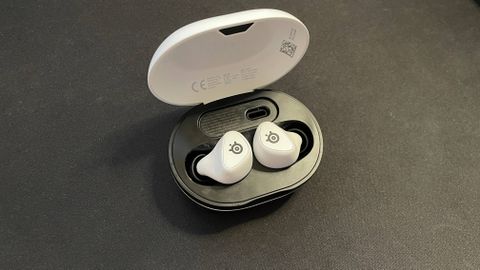Our Verdict
The SteelSeries Arctis GameBuds might cost a pretty penny, but they're worth it in all respects. Versatile, easy to use, gorgeous, and capable of pumping out some seriously high-quality audio, they'd be a great addition to anyone's setup.
For
- Incredible audio quality for earphones
- Game-specific audio profiles are useful and easy to change
- Earphones and charging pod both look and feel wonderful
- Qi wireless charging
- Great battery life
Against
- Can only connect to one Bluetooth device at a time
- WearSense (auto-pause when earbuds are removed) is a little sensitive
PC Gamer's got your back
When I got my hands on the SteelSeries Arctis GameBuds for the first time a little over a month ago, apart from being surprised that they actually fit my weird little ears, I was also surprised by how premium they look, feel, and sound. Now that I've had time to thoroughly test them, I'm pleased to say my initial impressions weren't skin-deep. These are incredible gaming earbuds that more than justify their admittedly steep price tag.
They're not expensive next to the PlayStation Pulse Explore and Sony InZone Buds, but they are pretty expensive compared to other options. After all, we're PC gamers 'round here, so we can swat aside all that "console" nonsense. And in the realm of earbuds for PC gaming, the Arctis GameBuds do face some competition at their $160 MSRP price point. The JBL Quantum TWS earbuds, for instance, do a lot of what the GameBuds do and often go on sale for a lot cheaper than their standard $150 price tag.
Make no mistake, though, the GameBuds do indeed do a lot, which goes a long way towards justifying their MSRP—not to mention their stellar audio quality, which we'll get to.
We're talking quick-switch Bluetooth 5.3 and 2.4 GHz USB-C connectivity, Active Noise Cancelling (ANC) and Transparency modes, impressive battery life, cross-console compatibility (depending on whether you buy the Xbox or PlayStation version), 360-degree spatial audio, Qi wireless charging, IP55 water resistance, "WearSense" tech that pauses playback when you remove the earbuds, plenty of left- and right-side button controls, and even a slot in the carry pod for the USB-C dongle. None of this is even to mention the SteelSeries GG software, phone app, game audio profiles and full parametric EQ customisation.
The GameBuds quite simply have everything you might want from gaming earbuds—at least, they have everything I found myself wanting. When it comes to ease of use and versatility, these little bad boys fire on all cylinders.
Commuting to work? Take them out of the case, slap them in your ears, and listen to music from your phone over Bluetooth. If you're on public transport, press the left earbud once to turn on ANC. At work, take your small 2.4 GHz USB-C dongle out of the case and use it to connect to your laptop. Press the right earbud three times to switch to 2.4 mode and toggle from ANC to Transparency mode with a press of the left earbud so you can hear your colleagues clearly.
On the way home, plug the dongle into your handheld gaming PC for some impromptu gaming. Quickly toggle to Bluetooth to connect to your phone when you receive a phone call, then toggle back. When you get home, your earbuds should still be close to full charge because the case holds 4x full charges and charges the earbuds when they're inside it. Drop the case on your Qi wireless charger to top it up, and you're good to go.
That might be an extreme example—few people use earbuds throughout the entire day—but it gets across the ease of use. In my own case, I found the ANC incredibly useful for blocking out chatter on trains and transparency mode useful for hearing my partner while I strolled about the house doing chores listening to an audiobook. That was all via Bluetooth, but I found it super easy to switch over to 2.4 for gaming on the Lenovo Legion Go, either in bed or on the sofa with it hooked up to the TV.




Thanks to the carry pod's charging, I've never had the GameBuds come close to running out of battery, either, even on days when using them for an entire workday and then travelling or gaming in the evening. There are always at least some intermissions where I can pop them into the pod and keep them fed. And the pod itself's found its home on my iPhone's MagSafe charger (a Nomad Stand One) which I lay down flat for the GameBuds.
Plus, during all this—and unusually for me, given I'd sworn off earbuds for so long—I didn't have a single complaint about comfort. They simply fit, snugly and with little imposition. If I'm to get picky, I'd say the WearSense tech is a little too sensitive. During a sweaty workout, it would occasionally think an earphone's come out and pause my music, but I've just learnt to disable WearSense when I'm gonna get sweaty—no biggie.
Mic quality is respectable, too, but they're still earbuds, so you're not getting anything amazing. Most even moderately decent headset mics should do better. Here's what it sounds like:
So, the GameBuds are incredibly convenient to use and everything works seamlessly—once you've done a little initial setup in SteelSeries GG for the 2.4 GHz mode, that is. They're also pleasant to use. Their case is smooth and feels good to hold, and after the earbuds have gracefully snapped into place thanks to some well-designed magnetism, it snaps shut with a satisfying thwack. The earphones themselves have mechanical buttons, too—none of this haptic touch malarkey.
None of this would matter, however, if the performance and audio quality weren't present to match it. Thankfully, the Arctis GameBuds deliver here, too.
The only real problem with the SteelSeries Arctis GameBuds is one that's caused by a very niche problem with my biology. You see, I have ears that can get very waxy. More so than a regular human—I've previously had to have them syringed by nurses, and regularly have to take topical medication to clear them out.
As such, I did manage to clog these bad boys, which caused a feedback issue with ANC enabled. After some cleaning, it was fine again, but during the process, I went too hard on the dust filter and tore it off. Oops. I managed to fix it back on, but not easily. Moral of the story: Be more careful than I was when cleaning out the GameBuds. This shouldn't be a problem for 99% of people though, because, as I said, my problem is a niche one.
Now, I'm no audio snob but I am partial to my audiophile Sennheiser HD599 cans, and I can say that in comparison to these, the GameBuds stack up quite well. You're never going to get the full gamut of crystal-clear frequencies from small earphone drivers, but as far as earbuds go, SteelSeries has it nailed. Just remember to disable the noise limiter in the software if you want to crank this thing up, as it comes enabled by default for legal reasons.
There's definitely more clarity to some mids and highs (cymbals and syballances, and all that) with my 599s, but for earbuds the Arctis GameBuds are damn fantastic. Depending on which EQ you use, you can get a wide coverage from the 20–20,000 Hz response neodymium magnetic drivers, and the bass can be pretty punchy, too. Electric Wizard certainly said a heavier hello to me than they did on my 599s, but then again I'm not a bass-head and like to keep my 599 EQ'd pretty tamely.
Speaking of EQ, though, you're going to want to slap some on the GameBuds, and that's where the presets come in. We've seen these before with the Arctis Nova 5X, but I think they make much more sense for GameBuds.
Whether in SteelSeries GG for PC or the SteelSeries Arctis app for Android and iOS, you get a wide range of tailored EQs to choose from, for specific games as well as for some general uses such as for music or movies. You can set the earphones to use one pre-set profile for 2.4 GHz use and a different one for Bluetooth use, too—perhaps gaming for the former and music for the latter.
If you're using SteelSeries GG, you can even use Sonar to apply different profiles to different audio channels and then set these channels to be used for specific apps. For instance, I use the aux channel with the Punchy Music preset for Spotify and the media channel for my browsers with a Movie preset.

For gaming, it depends on what game I'm playing. Some profiles are even developed by pro teams or players rather than by SteelSeries, and my experience with these profiles has been great.
I found FaZe's CS2 profile, for instance, to offer genuinely clearer audio in CS2, allowing for easier placements of footsteps and just a generally more pleasant audio experience. But when I used this profile in Overwatch 2, it was rubbish, as you'd expect. So I slapped on an Overwatch 2 preset and it sounded great. I couldn't find other presets that sounded better for it—not even ones I thought might work more generally, such as the Music ones.
The only real downside is that there aren't presets for every game. I was disheartened to find that there wasn't one for DOOM Eternal, for example, as I like to use it for testing. Currently, there are about 180 presets to choose from (and not all are gaming ones), although you can find more being shared around by users on the SteelSeries Discord and other places. Of course, there's also the option to customise EQs yourself, and SteelSeries GG includes a shiny new parametric EQ to help with this.
✅ You want high-quality audio: The Arctis GameBuds come close to over-ear audio quality, especially if tuned right.
✅ You use earbuds for many different things: These GameBuds are incredibly versatile thanks to ANC, Transparency mode, and quick-switching between Bluetooth and 2.4 GHz.
❌ You're on a budget: While they're certainly worth the price if you're looking for a premium pair of earphones, the Arctis GameBuds are expensive.
❌ You need to connect to multiple Bluetooth devices: The GameBuds can only connect to one Bluetooth device at a time.
As part of my overarching attempt to use Crab Champions to test every single component or peripheral I review, I decided to use the game to test the GameBuds' latency. Apart from the absurd factor, this game's a good choice because, in my experience, it's incredibly snappy and well-optimised.
As one would expect, latency is fantastic when connected over 2.4 GHz—I noticed nary a single delay between the crab visually dash-jumping and the corresponding "oof" sound caressing my ears.
Connecting over Bluetooth did add a little latency, however: enough that I noticed it, but not enough for it to make gameplay annoying. Gunshots still sounded like they were happening when they actually were, provided I didn't pay too much attention to the muzzle flash.
I can't help but feel like that slight bit of Bluetooth latency really doesn't matter with these earbuds, though. I mean, the case has a USB-C slot, for goodness' sake. I didn't notice much of a drop in audio quality when switching from Bluetooth to 2.4 GHz, but I still don't see myself gaming over Bluetooth when 2.4 is an option, even if it does end up knocking an hour or two off the battery life. The pod charges the earbuds so easily and conveniently, after all. And if charging speed's a concern, connecting the pod via cable allows for fast charging, which translates to 15 minutes charging for 3 hours worth of power.
In all, there's incredibly little to dislike about the SteelSeries Arctis GameBuds. The only question is pricing, and on that front, I think the price tag is justified for those looking for a truly premium set of earbuds.
Compared to the JBL Quantum TWS, for example, yes, both have similar features—ANC, transparency mode, on-ear controls, quick 2.4 GHz and Bluetooth switching, and so on—but the SteelSeries pair just does things that bit better. It has much better battery life, sounds better than plenty of over-ear headsets, has physical buttons rather than touch controls, and offers all the Sonar preset gubbins to boot. Plus, it rounds all this out with an incredibly suave design that does feel the $160 (£159 / AU$359) part.
Before I'd tried the Arctis GameBuds out properly when I heard how much they were going to cost I was sceptical. I thought okay, they're nice, but are they that nice? Now that I've tested them extensively, I can answer: Yes, they are. They won't be for everyone, because premium earphones aren't for everyone, but for those in the market, they're a fantastic versatile and high-quality pair of earbuds.
The SteelSeries Arctis GameBuds might cost a pretty penny, but they're worth it in all respects. Versatile, easy to use, gorgeous, and capable of pumping out some seriously high-quality audio, they'd be a great addition to anyone's setup.

Jacob got his hands on a gaming PC for the first time when he was about 12 years old. He swiftly realised the local PC repair store had ripped him off with his build and vowed never to let another soul build his rig again. With this vow, Jacob the hardware junkie was born. Since then, Jacob's led a double-life as part-hardware geek, part-philosophy nerd, first working as a Hardware Writer for PCGamesN in 2020, then working towards a PhD in Philosophy for a few years (result pending a patiently awaited viva exam) while freelancing on the side for sites such as TechRadar, Pocket-lint, and yours truly, PC Gamer. Eventually, he gave up the ruthless mercenary life to join the world's #1 PC Gaming site full-time. It's definitely not an ego thing, he assures us.

The Nvidia App has finally launched out of beta and if you really hate remembering your login for GeForce Experience you should try it

Eric Barone warns that Stardew Valley's hat mouse has gone missing, but only in Spanish games

Nvidia has reportedly killed production of all RTX 40 GPUs apart from the 4050 and 4060 as affordable 50-series GPUs could arrive earlier than expected

